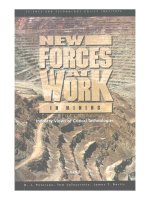mining minerals in geology
Bạn đang xem bản rút gọn của tài liệu. Xem và tải ngay bản đầy đủ của tài liệu tại đây (2.42 MB, 30 trang )
MINERALS & MINING
APES
CHAPTER 27 (PGS 588-601)
2009
Economic mineralogy
• Study of minerals heavily
used in manufacturing.
• Important part of
domestic & international
commerce
• Mostly metal ores
• Some non-metallics are:
graphite, quartz,
diamonds
• Many resources are
spread out- important to
find them concentrated in
economically recoverable
levels.
Metal Resources
Metal
Uses
Millions Metric
Tons Annually
Iron
Heavy machinery, steel production
740
Aluminum
Packaging foods & beverages,
transportation, electronics
40
Manganese
High-strength, high-resistant steel
alloys
22.4
Copper
Building construction, electric/electroni
industry
8
Chromium
High strength steel alloy
8
Nickel
Chemical industry, steel alloys
0.4
Lead
Leaded gasoline, car batteries, paint,
ammunition
Silver
Photography, electronics, jewelry
Gold
Medical, aerospace, electronic use,
money, jewelry
Platinum
Automobile catalytic converters,
electronics, medical uses, jewelry-
Metal Resources
Biggest Users of Metals
• United States
• Japan
• Europe
Biggest Producers
• South America
• South Africa
• Former Soviet Union .
Non-Metal Resources
• Sand & gravel (highest volume & dollar value than any
other non-metal & greater volume than metals)
– Uses: brick & concrete construction, paving, road filler,
sandblasting, glass (high silica content sand)
• Limestone
– Uses: concrete, road rock, building stone, pulverized to
neutralize acidic soil or water.
• Evaporites- halite, gypsum, potash
– Uses: halite- rock salt for roads, refined into table salt
– Gypsum- makes plaster wallboard
– Potash- for fertilizer (potassium chloride, potassium sulfates)
• Sulfur deposits
– Uses: sulfuric acid in batteries & some medicinal products
Strategic Metals & Minerals
• We depend on about
80 metals & minerals
• 18 of these are
considered rare & in
short supply
– EX: Tin, platinum,
gold, silver, & lead
• Some are strategic
resources- we use but
cannot produce
ourselves.
Strategic Metals & Minerals
•
If foreign politics, government
are unstable, could cut off
supplies, causing a crippling of
economy or military strength
• We stockpile when resource is
cheap & available “just in
case.”
• EX: bauxite (ore containing
aluminum), manganese,
chromium, tin, cobalt,
tantalum, palladium, platinum
• Many LDC sell their strategic
resources to make money for
country.
– Zambia- 50% of national
income comes from cobalt
exports.
Steps in Obtaining Mineral
Commodities
• Prospecting- finding places where ores occur
• Mine exploration & development- learn
whether ore can be extracted economically
• Mining- extract ore from ground
• Beneficiation- separate ore minerals from other
mined rock
• Smelting & refining- extract pure mineral from
ore mineral (get the good stuff out of waste rock)
• Transportation- carry mineral to market
• Marketing & sales- find buyers & sell the
mineral
Types of Mining
• Surface- scoop ore off
surface of the earth or dig
big holes and scoop
– Cheap
– Safe for miners
– Large amount of
environmental destruction
• Subsurface- use shafts to
reach deeply buried ores
– Expensive
– Hazardous for miners
– Less environmental
damage
Types of Surface
Mining
1. Open Pit Mining
a. Overlaying material
is removed using
large equipment
b. Creates pits that are
hundreds of meters
wide and hundreds
of meters deep.
Types of Surface Mining
2. Strip mining
– Like open pit but not
as deep of a pit
– Same environmental
damage
Large bucket wheel extractor being moved through Germany. Moves 10
meters per minute. Takes 5 people to operate. Used in strip mining
Types of Subsurface mining
•
Variety of methods
•
Uranium mining
Types of Subsurface Mining
• Dredging
– Sand is removed from
bottom of ocean
– Can be done to
restore beaches (after
hurricane)
– Destroys fragile
benthic ecosystems
Mining
Issues
Mine Safety:
In U.S., stringent
mining regulations
have lead to a
reduction in fatalities,
both in terms of total
deaths per year, deaths
per person-hour
worked, and deaths
per ton mined.
surface
Health Problems
•
•
•
•
•
•
•
•
mine collapse
fire (methane, coal dust, etc.).
asphyxiation (methane, carbon
monoxide)
pneumoconiosis (from inhaling
coal dust)
asbestosis (from inhaling
asbestos fibers)
silicosis (from inhaling silicate
dust)
heavy metal poisoning (e.g.
mercury)
radiation exposure (in uranium
mining)
Environmental Damage
•
•
•
•
•
•
•
•
Gaping holes in ground (old open pit mines)
Accidental draining of rivers and lakes
Disruption of ground water flow patterns
Piles of gangue- mine tailings (mining waste)
Loss of topsoil in strip-mined regions (350 to 2,700 km 2 in US alone)
Spoil banks are where holes were filled in with waste- cheap & easysusceptible to erosion, chemical weathering, causes high sediment runoff in
watersheds. Steep slopes are slow to re-vegetate (succession happens
slowly- no topsoil)
Contamination of soil or water from heavy metals (e.g. arsenic, mercury) in
mine tailings.
Contamination from sulfuric acid (H2SO4) produced through weathering of
iron sulfide (FeS2, pyrite) in tailings.
– 4FeS2 + 14H2O = 4Fe(OH)3 + 8H2SO4
•
Water leaking into mine shafts, washes dissolved metals & toxic material into
water sources.
– (550,000 abandoned mines in U.S.- 12,000 mi of rivers & streams contaminated
with mine drainage- cost to clean up $32-$72 billion)
Coeur D' Alene Mine in Colorado
“Gangue”- mine tailings
Acid Mine Drainage
Acid Mine
Drainage
The impact of mine drainage
on a lake after receiving
effluent from an
abandoned tailings
impoundment for over 50
years
Relatively fresh tailings in an
impoundment.
/>
The same tailings impoundment
after 7 years of sulfide
oxidation. The white spots in
Figures A and B are gulls.
Mine effluent
discharging from
the bottom of a
waste rock pile
(gangue)
Shoreline of a
pond receiving
AMD showing
massive
accumulation
of iron
hydroxides on
the pond
bottom
Surface Mining Control &
Reclamation Act (SMCRA)
•
•
1977
Requires better restoration of
strip-mined lands
• Restoration is difficult &
expensive
• Takes long time for soil to
regain fertility
– Topsoil gets buried
– Compacted, poor drainage
– Root growth restricted
•
•
Minimum cost- $1000 per acre
Complete restoration (if
possible)- $5,000 per acre









